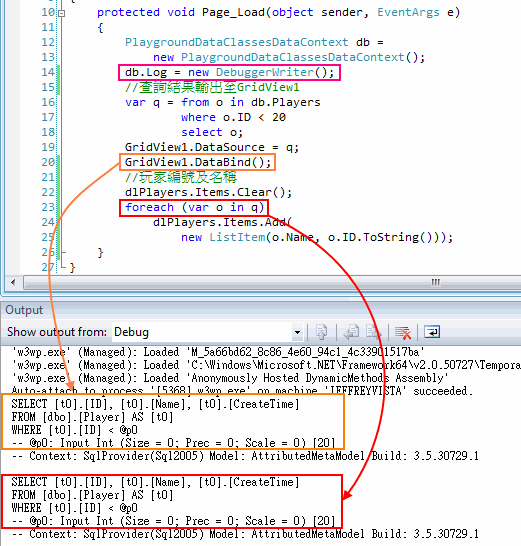在ASP.NET中觀察LINQ to SQL所產生的T-SQL語法
| | | 2 | |
接連在好幾個小專案裡用了LINQ to SQL,慢慢掌握要領,煎、煮、炒、炸查詢、新增、修改、刪除,各種料理操作都已能手到擒來,就愈發感受到它的便利性。
說穿了,LINQ to SQL只不過是ORM的一種具體實踐,並無深奧學問,之所以用來得心應手、讓人驚豔,不外乎是在與Visual Studio 2008整合深度上佔了優勢。以一個開發者的角度而言,我不在乎這對其他解決方案是否公允? 也不關心這類綁標圖利是否會有爭議? 給我方便的開發工具,其餘免談。
過去曾用ADO/ADO.NET開發過很長一段時間,在效能議題上下過一些功夫。切換到LINQ to SQL後,完全不沾SqlConnection、SqlCommand、SqlParameter就能搞定與資料庫相關的大小事,固然讓人心曠神怡;但過去對效能斤斤計較,換到LINQ,我還是常常懷疑LINQ所自動轉譯成的T-SQL到底長得什麼德性,會不會荒腔走板、效能低落?
要解除疑慮,最直接有效的方法就是檢查LINQ to SQL所產出的T-SQL語法,沒有什麼比眼見為憑更具說服力了! System.Data.Linq.DataContext類別有個屬性叫Log,我們可以接上一個TextWriter,DataContext會在執行T-SQL指令時,輸出實際使用的T-SQL語法、參數細節,提供極佳的觀察與偵錯資訊。
不過,如MSDN文件所示,能找到的Log應用範例幾乎都是接上Console.Out適用於Console Application,如果我們是在網頁中執行,想要如同System.Diagnositcs.Debug.WriteLine一般輸出在VS2008的偵錯輸出視窗,該怎麼做呢?
我找到了Kris Vadermotten寫的DebuggerWriter類別,可以滿足以上的需求:
using System;using System.Diagnostics;using System.Globalization;using System.IO;using System.Text; /// <summary> /// Original by Kris Vadermotten: http://www.u2u.info/Blogs/Kris/Lists/Posts/Post.aspx?ID=11 <br /> /// Remixed by Jeffrey Lee, 2009-07-11 http://blog.darkthread.net<br /> /// Implements a <see cref="TextWriter"/> for writing information to the debugger log. /// </summary> /// <seealso cref="Debugger.Log"/>public class DebuggerWriter : TextWriter
{private bool isOpen;
private static UnicodeEncoding encoding =
new UnicodeEncoding(false, false);
public int Level { get; private set; }
public string Category { get; private set; }
/// <summary> /// Initializes a new instance of the <see cref="DebuggerWriter"/> class. /// </summary> public DebuggerWriter() : this(0, Debugger.DefaultCategory) { } /// <summary> /// Initializes a new instance of the <see cref="DebuggerWriter"/> class with the specified level and category. /// </summary> /// <param name="level">A description of the importance of the messages.</param> /// <param name="category">The category of the messages.</param>public DebuggerWriter(int level, string category)
: this(level, category, CultureInfo.CurrentCulture) { } /// <summary> /// Initializes a new instance of the <see cref="DebuggerWriter"/> class with the specified level, category and format provider. /// </summary> /// <param name="level">A description of the importance of the messages.</param> /// <param name="category">The category of the messages.</param> /// <param name="formatProvider">An <see cref="IFormatProvider"/> object that controls formatting.</param>public DebuggerWriter(int level, string category, IFormatProvider formatProvider)
: base(formatProvider) {Level = level;
Category = category;
this.isOpen = true;
}
protected override void Dispose(bool disposing)
{ isOpen = false; base.Dispose(disposing);}
public override void Write(char value)
{ if (!isOpen)throw new ObjectDisposedException(null);
Debugger.Log(Level, Category, value.ToString());}
public override void Write(string value)
{ if (!isOpen)throw new ObjectDisposedException(null);
if (value != null)
Debugger.Log(Level, Category, value);}
public override void Write(char[] buffer, int index, int count)
{ if (!isOpen)throw new ObjectDisposedException(null);
if (buffer == null || index < 0 || count < 0 || buffer.Length - index < count)
base.Write(buffer, index, count); // delegate throw exception to base class
Debugger.Log(Level, Category, new string(buffer, index, count));
}
public override Encoding Encoding
{ get { return encoding; }}
}
將以上的DebuggerWriter.cs放入App_Code,然後youDataContext.Log = new DebuggerWriter(),設定Breakpoint,再一列一列Debug,你就可以觀察到何時LINQ to SQL會執行什麼樣的T-SQL指令,甚至包含參數值等細節,很犀利吧?

以上的範例,其實會觸發兩次SQL查詢,若要再精簡,可以改寫成:
var q = (from o in db.Players
where o.ID < 20
select o).ToList<Player>();
大家實際動手玩玩便知。
【2009-07-12補充】艾小克提供可以整合在VS2008裡,在開發階段檢視查詢所對應T-SQL並可直接試連DB做查詢的工具一枚,十分實用,一併列出供大家參考。
【2009-07-13補充】本草綱目有記載,若要查Query對應的CommandText,可以用DataContext.GetCommand,Insert/Update/Delete的部分則還沒看到Log法的替代方案,如有線報,歡迎提供。
Comments
# by demo
我都是使用LinqPad直接看他會丟什麼給我個人覺得還滿好用的 http://demo.tc/view.aspx?id=516
# by jane
你的文章幫助我很多~~謝謝^^ 幫我更快能找出LINQ的問題